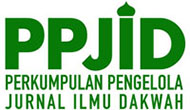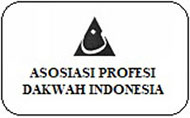Model Dakwah Compliance Gaining oleh Kyai Pesantren (Compliance Gaining Dakwah Model by the Kyai of Islamic Boarding School)
Abstract
Keywords
Full Text:
PDFReferences
Aristyavani, I. (2017). Persuasi Komunikasi Dan Kebijakan Publik (Pertama). Gerbang, Calpupis Candi.
Atiqullah. (2013). Perilaku Kepemimpinan Kolektif. Pustaka Radja.
Bukhori. (2018). Pengembangan Kurikulum Pesantren Salafiyah dalam Meningkatkan Mutu Pendidikan Pondok. 10(1), 279–288.
Creswell, J. W. (2009). Research Design Qualitative, Quantitative and Mixed Metods Approaches (Cetakan VI). Pustaka Pelajar.
Daud, Z. (2012). Model Perilaku Kepatuhan Zakat: Suatu Pendekatan Teori. Jurnal Iqtishoduna, Mueller 1986.
Fahham, A. M. (2015). Pendidikan Pesantren: Pola Pengasuhan, Pembentukan Karakter, Dan Perlindungan Anak (Cetakan I). Pusat Pengkajian, Pengolahan Data dan Informasi (P3DI) Sekretariat Jenderal DPR RI.
Helmy, M. (1973). Dakwah dalam Alam Pembangunan. CV. Toha Putra.
Indra, H. (2019). Pesantren salafiyah education to building the characters of nation. International Journal of Scientific and Technology Research, 8(10), 839–841.
Jones, P. (2010). Pengantar Teori-Teori Sosial Dari Teori Fungsionalisme hingga Post-modernisme. Yayasan Pustaka Obor Indonesia.
Kamaruddin, A. (2017). Analisis Kualitatif Terhadap Faktor Kegagalan Komunikasi Pembujukan dalam Konteks Pengucapan Awam (Qualitative Analysis of Factors that contribute to the Failure of Persuasive Communication in the Context of Public Speech). Jurnal Komunikasi, Malaysian Journal of Communication, 33(3), 89–106.
Kementrian Agama RI. (2014). Al-Quran Tajwid dan Terjemahan. Penerbit Abyan.
Madjid, N. (1997). Bilik-Bilik Pesantren. Pramadina.
Masduki. (2017). Toleransi di Masyarakat Plural Berbasis Budaya Lokal. Jurnal Sosial Budaya, 3(1), 87.
Moleong, L. J. (2018). Metodologi Penelitian Kualitatif. PT Remaja Rosdakarya.
Mubasyaroh, M. (2017). Strategi Dakwah Persuasif dalam Mengubah Perilaku Masyarakat. Ilmu Dakwah: Academic Journal for Homiletic Studies, 11(2), 311–324.
Muhiddin, A. (2002). Dakwah Dalam Prespektif Al-Quran. CV Pustaka Setia.
Mulyana, D. (2017). Ilmu Komunikasi Suatu Pengantar. PT Remaja Rosdakarya.
Muriah, S. (2000). Metode Dakwah Kontemporer. PT Mitra Pustaka.
Ni’am, S. (2015). Pesantren: The miniature of moderate Islam in Indonesia. Indonesian Journal of Islam and Muslim Societies, 5(1), 111–134.
Rahmadanty, M. (2019). Compliance Gaining dalam Persuasi Komunikasi dan Kebijakan Publik Pemerintah Kota Bukittinggi Terkait Pembangunan Pasar Atas. Jurnal Ilmu Pemerintahan Widya Praja, 45(2), 167–176.
Richard West, L. H. T. (2008). Pengantar Teori Komunikasi Analisis dan Aplikasi (N. Setyaningsih (ed.); 3rd ed.). PT Salamba Humanika.
Rosidi, I., & Amin, M. (2019). Dakwah Zakat: Menyebarkan Kewajiban Berzakat Di Kalangan Masyarakat Petani Di Kepulauan Meranti. Jurnal Dakwah Risalah, 30(1), 74.
Setyowati, Y. (2016). Tindakan Komunikatif Masyarakat “Kampung Preman” dalam Proses Pemberdayaan. Jurnal ASPIKOM, 3(1), 16.
Sintaasih, W. G. S. D. K. (2017). Pengantar Perilaku Organisasi Teori, Kasus Dan Aplikasi Penelitian (Cetakan I). CV. Setia Bakti.
Subejo, P. . (2016). Menuju Pergeseran Paradigma Komunikasi Pembangunan di Indonesia. Seminar Nasional “Srategi Pemberdayaan Masyarakat Di Masyarakat Ekonomi ASEAN (MEA)” Prodi S2/S3 Penyuluhan Dan Komunikasi Pembangunan Sekolah Pascasarjana Universitas Gadjah Mada.
Sugiyono. (2011). Metode Penelitian Kuantitatif Kualitatif dan RgD. Alfabeta.
Sukayat, T. (2015). Ilmu Dakwah : Perspektif Filsafat Mabadi ‘Asyarah. Simbiosa Rekatama Media.
Syahroni. (2016). Risalatul Amaliyah Pondok Pesantren Thoriqul Huda (M. Irfan (ed.); Cetakan I). Koperasi PPTH.
Tasmara, T. (1987). Komunikasi Dakwah. PT Media Pratama.
Taufiq, A. (2020). the Dynamic Views of Kiais in Response. Qudus International Journal of Islamic Studies (QIJIS), 8(1), 1–32.
Wardi, M. (2015). Peranan Pondok Pesantren Azzubir dalam Pembinaan Akhlaq Masyarakat Desa Talesah Kecamatan Tlanakan Kabupaten Pamekasan. Jurnal Penelitian Dan Pemikiran Keislaman, 2(1), 36–46.
Warson Munawwir. (1994). Kamus al Munawwir. PT Pustaka Progresif.
Yakub, A. M. (1997). Sejarah dan Metode Dakwah Nabi. PT Pustaka Firdaus.
Zarkasyi, H. F. (2020). Imam Zarkasyi ’ S Modernization of Pesantren in Indonesia. Qudus International Journal of Islamic Studies (QIJIS), 8(1), 161–200.
DOI: http://dx.doi.org/10.24014/jdr.v31i2.11484
Refbacks
- There are currently no refbacks.

This work is licensed under a Creative Commons Attribution-ShareAlike 4.0 International License.
Editorial Office:
2nd Floor, Building of Faculty of Da'wah and Communication, Universitas Islam Negeri Sultan Syarif Kasim Riau. Jl. HR Soebrantas Km 15, Simpangbaru, Tampan, Pekanbaru
Email : jurnalrisalah@uin-suska.ac.id

This work is licensed under a Creative Commons Attribution-ShareAlike 4.0 International License.














